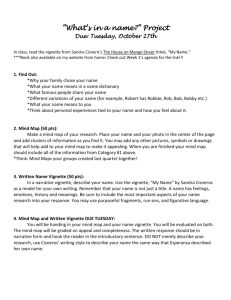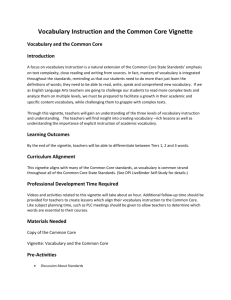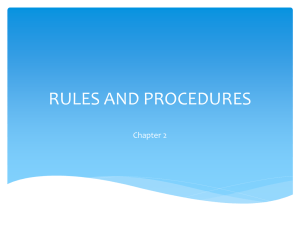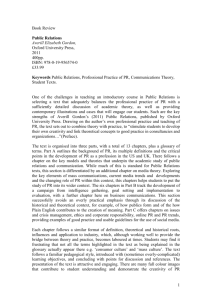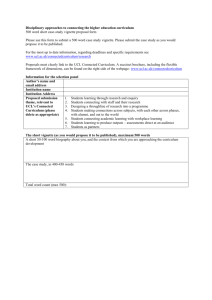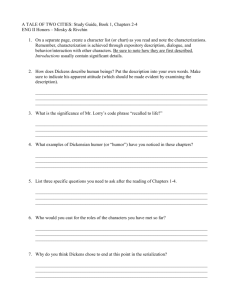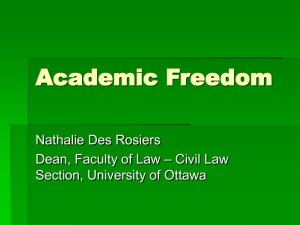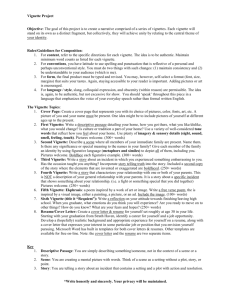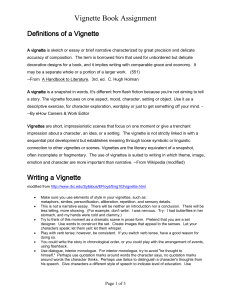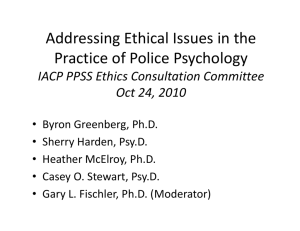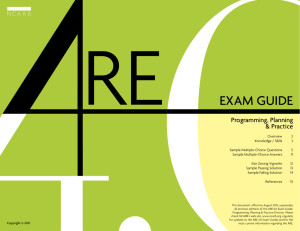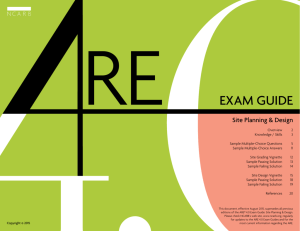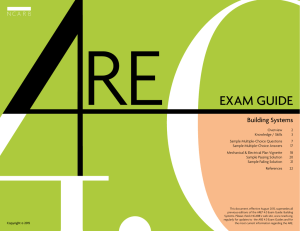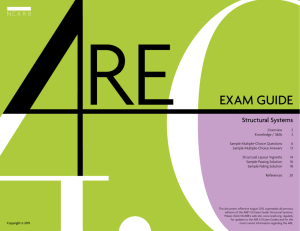Principles of Language Learning and Teaching
advertisement
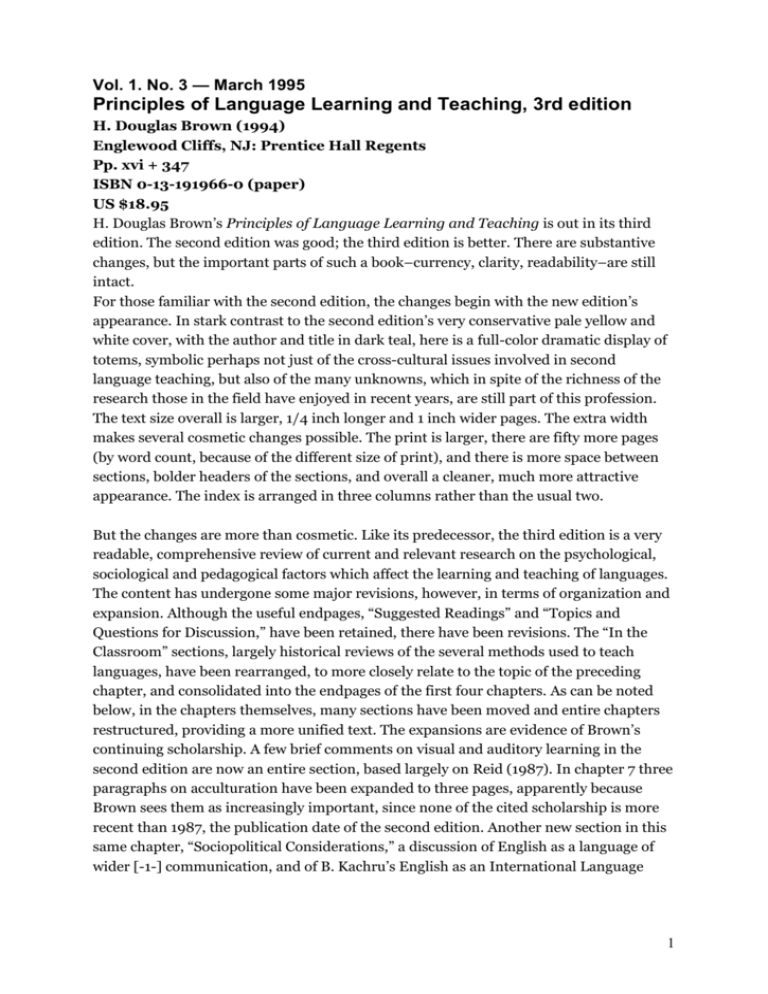
Vol. 1. No. 3 — March 1995 Principles of Language Learning and Teaching, 3rd edition H. Douglas Brown (1994) Englewood Cliffs, NJ: Prentice Hall Regents Pp. xvi + 347 ISBN 0-13-191966-0 (paper) US $18.95 H. Douglas Brown’s Principles of Language Learning and Teaching is out in its third edition. The second edition was good; the third edition is better. There are substantive changes, but the important parts of such a book–currency, clarity, readability–are still intact. For those familiar with the second edition, the changes begin with the new edition’s appearance. In stark contrast to the second edition’s very conservative pale yellow and white cover, with the author and title in dark teal, here is a full-color dramatic display of totems, symbolic perhaps not just of the cross-cultural issues involved in second language teaching, but also of the many unknowns, which in spite of the richness of the research those in the field have enjoyed in recent years, are still part of this profession. The text size overall is larger, 1/4 inch longer and 1 inch wider pages. The extra width makes several cosmetic changes possible. The print is larger, there are fifty more pages (by word count, because of the different size of print), and there is more space between sections, bolder headers of the sections, and overall a cleaner, much more attractive appearance. The index is arranged in three columns rather than the usual two. But the changes are more than cosmetic. Like its predecessor, the third edition is a very readable, comprehensive review of current and relevant research on the psychological, sociological and pedagogical factors which affect the learning and teaching of languages. The content has undergone some major revisions, however, in terms of organization and expansion. Although the useful endpages, “Suggested Readings” and “Topics and Questions for Discussion,” have been retained, there have been revisions. The “In the Classroom” sections, largely historical reviews of the several methods used to teach languages, have been rearranged, to more closely relate to the topic of the preceding chapter, and consolidated into the endpages of the first four chapters. As can be noted below, in the chapters themselves, many sections have been moved and entire chapters restructured, providing a more unified text. The expansions are evidence of Brown’s continuing scholarship. A few brief comments on visual and auditory learning in the second edition are now an entire section, based largely on Reid (1987). In chapter 7 three paragraphs on acculturation have been expanded to three pages, apparently because Brown sees them as increasingly important, since none of the cited scholarship is more recent than 1987, the publication date of the second edition. Another new section in this same chapter, “Sociopolitical Considerations,” a discussion of English as a language of wider [-1-] communication, and of B. Kachru’s English as an International Language 1 movement, recognizes the growing understanding that there is not only one “correct” English. The third edition offers the language teacher trainer and her students a readable, comprehensive text on language learning issues. Chapter 1, a good review of the relationship between the nature of language and teaching language, as well as a discussion regarding current trends in linguistics and psychology, provides the reader with a firm introduction to the field of language teaching. This chapter now includes the section on applied linguistics as it relates to language teaching, moved from chapter 8 in edition 2. Chapter 2 surveys theories of first language acquisition. The content has been reworked and updated from the second edition, but the basic concepts are intact. In this teacher trainer’s opinion, this is one of the most useful chapters of the book, because it helps those new to the field of language teaching to relate information that they may have learned elsewhere to issues of importance to learning and teaching a second language. Chapter 3, using the theories presented in chapter 2, compares and contrasts relevant research on first and second language acquisition. In chapters 4 and 5, those who are familiar with edition 2 will recognize significant changes. By moving three sections from chapter 5 to chapter 4, namely “Types of Learning,” “Transfer, Interference, and Overgeneralization,” and “Inductive and Deductive Reasoning,” Brown has created in chapter 4 a discussion more focussed on human learning in general than was formerly the case. Moving these sections also enables Brown to focus, in chapter 5, on individual approaches to language learning. He recognizes this shift of focus by retitling the chapter “Styles and Strategies.” Chapter 6 deals with personality factors of the learner, i.e. inhibitions, self-esteem, and anxiety. One of the insights Brown includes in the anxiety section is the concept that a certain amount of anxiety actually enhances learning. The vignette here is “Putting Methods into Perspective,” a discussion of the recognition that there is no single perfect method. Chapter 7 addresses more global social factors, such as classroom culture and acculturation. The vignette here discusses how the language teacher can develop a principled approach to choosing the appropriate methods, and provides a check list of “Intrinsically Motivating Techniques” as a guide in making that decision. The greatest changes in the third edition are in chapters 8 and 9. In chapter 8, the section “Error Analysis,” moved from chapter 9, has been added to the sections “Interlanguage” and “The Contrastive Analysis Hypothesis,” along with a new section, “Markedness and Universal Grammar.” The vignette in chapter 8 provides ideas for effective error correction. In chapter 9 are now many of the issues [-2-] about communicative competence found in the earlier version in chapter 10, along with welcome new additions, “Pragmatics,” and “Language and Gender.” The vignette traces 2 the development of what is now called communicative language teaching from the earlier notional-functional syllabus. For those who are unfamiliar with issues of test design, chapter 10, dealing with the practicality, reliability and validity of testing, is a good introduction. For those who have forgotten, it provides a good review. To compliment this chapter, the “In the Classroom” vignette is “Steps to Creating Intrinsically Motivating Tests.” The final chapter, “Theories of Second Language Acquisition,” is largely a discussion of Krashen’s Input Hypothesis and the theories of McLaughlin and Bialystok, who have questioned Krashen’s theory. The final vignette, intriguingly titled, “Out on a Limb: The Ecology of Language Acquisition,” is illustrated by Brown’s own extended metaphor to clarify the interrelatedness of many of the concepts discussed in his text. As is the case with all texts, Principles of Language Learning and Teaching has some shortcomings. The first one may be seen as a superficial one–until you have been reading the text for a while. The seven-inch page format, fourteen when open, makes handling this text awkward. The book flips and flops around; it is tiring to hold if you are a bookholding reader, and it curves too much for easy reading if you are a lap reader. Apart from that, the wider book means a wider reading line, which may be difficult for both lap and book-holding readers to process efficiently. (Who sits at a desk and places a book flat before herself, if she is going to read for one or more hours at a sitting?) In terms of content, although the expanded explanation of B. Kachru’s World Englishes is welcome, it is lamentable that Brown still does not recognize an older, somewhat related concept, that of contrastive rhetoric, which holds that text organization patterns do vary across cultures and genre. Perhaps this notion was not included because the text neither contains material regarding writing or reading theory, nor refers to the very interesting research in learning vocabulary. It may be that Brown considers these topics too close to the methodology area, yet these topics have all developed some very useful hypotheses which need to have a place in a text such as this. It is hoped that these oversights will be addressed in edition 4. Finally, sometimes the text seems full of endless charts and lists. At these points, there seem to be so many concepts that are somewhat but not quite similar, that it becomes difficult to keep them mentally organized and arranged. In spite of the book’s overall readability, some conflicts and cross-interpretations emerge which are not always successfully resolved. Many may complain about this lack of “authority.” Rather than being a weakness, I view this complexity of concepts as a very accurate reflection of the field today. Brown sends a clear message. We [-3-] have come a very long way in the past thirty years, in terms of seeking a theoretical base for our field. We have come far enough to realize how much we really don’t know. If a person wants to have all the answers in a conveniently reliable package, then ESL is not the field to be in. On the other hand, because there are so many unknowns, this is an exciting, challenging, vibrant field of inquiry. 3 I am looking forward to teaching out of this text next spring. Brown says in his introduction that he assumes no prior linguistic knowledge; he succeeds in reaching that goal. My students who used the second edition generally praised its accessibility. They were especially appreciative of the fact that the style and tone made most of the many new concepts comprehensible. The scaffolding of the new edition, with its rearrangement of many sections, is improved, and the content, overall, provides a sound foundation for those entering the language teaching field. As for those unresolved issues, they will become points from which we can generate thought-provoking discussions and perhaps some useful research. Reference Reid, J. M. 1987. The learning style preferences of ESL students. TESOL Quarterly, 21, 87-111. Shirley E. Ostler Bowling Green State University <sostler@bgnet.bgsu.edu> 4

